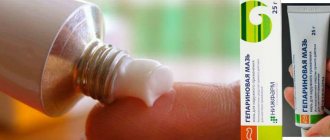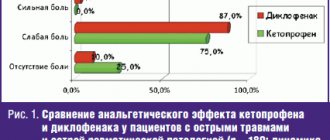Thrombogel 1000 gel for external use 1 thousand IU 30g
Compound
Active ingredient: sodium heparin - 1000 IU;
Excipients: carbomer (carbopol 980 NF), levomenthol, methyl parahydroxybenzoate, propyl parahydroxybenzoate, ethanol, trolamine (triethanolamine), purified water.
Pharmacokinetics
A small amount of heparin is absorbed from the skin surface into the systemic circulation. The maximum concentration of the drug in the blood is observed after application. Elimination of heparin mainly occurs through a half-life of 12 hours. Does not penetrate the placental barrier.
Indications for use
- Diseases of the superficial veins: varicose veins, chronic venous insufficiency and related complications (superficial thrombophlebitis, superficial periphlebitis);
- blunt injuries and soft tissue bruises;
- subcutaneous hematomas (including hematomas after phlebectomy);
- localized infiltrates and swelling of soft tissues.
Contraindications
- Hypersensitivity to heparin or to any of the components of the drug;
- violation of the integrity of the skin at the site of application of the drug (ulcerative-necrotic changes in the skin);
- traumatic violation of the integrity of the skin (open wounds);
- increased tendency to bleeding, thrombocytopenia;
- age under 18 years (the safety and effectiveness of the drug have not been studied).
Directions for use and doses
Externally. Apply a thin layer to the affected area at the rate of 3-5 cm of gel per area of skin with a diameter of 3-5 cm and gently rub into the skin. Apply 1-3 times a day daily until the inflammatory phenomena disappear, on average from 3 to 7 days. If there is no improvement after treatment, or symptoms worsen, or new symptoms appear, you should consult your doctor. Use the drug only according to the indications, the method of use and in the doses indicated in the instructions for use.
Storage conditions
In a place protected from light at a temperature not exceeding 25°C. Keep out of the reach of children.
Best before date
3 years. Do not use after the expiration date stated on the package.
special instructions
Do not exceed the maximum duration and recommended doses of the drug without consulting your doctor!
Should not be used for bleeding, applied to open wounds, mucous membranes, or in the presence of local purulent processes. The use of the gel is not recommended for deep venous thrombosis.
It is necessary to carefully monitor blood clotting (INR, prothrombin time) with prolonged use of the drug Thrombogel 1000 on large areas of the skin in patients simultaneously taking indirect anticoagulants (warfarin, acenocoumarol, etc.).
The penetration of heparin into healthy skin has been described in the case of topical application; Therefore, if thromboembolic complications are suspected, a platelet count should be checked to differentiate heparin-induced thrombocytopenia type II.
Therefore, regular platelet count checks in patients with a history of thromboembolic complications are necessary whenever heparin is used (before starting heparin, on the first day after starting use, and then regularly every 3-4 days during treatment until the end of treatment).
Thrombogel 1000 contains methyl parahydroxybenzoate and propyl parahydroxybenzoate as excipients, so it cannot be used in patients with allergies to parabens.
Description
Direct acting anticoagulant for local use.
Use in children
Due to limited experience with the drug in children and because there is insufficient research data, the gel should not be used in the treatment of children.
Pharmacodynamics
Direct anticoagulant, belongs to the group of medium molecular heparins. When used externally, it has a local antithrombotic, antiexudative, and moderate anti-inflammatory effect. Blocks the formation of thrombin, inhibits the activity of hyaluronidase, and activates the fibrinolytic properties of the blood. Heparin, gradually released from the gel and passing through the skin, reduces the inflammatory process and has an antithrombotic effect, improves microcirculation and activates tissue metabolism, thereby accelerating the resorption of hematomas and blood clots and reducing tissue swelling.
Side effects
In some cases, hypersensitivity reactions to the components of the drug may occur, manifested by redness of the skin and/or itching, which usually disappear after stopping the use of the drug.
The drug may cause delayed allergic reactions (for example, contact dermatitis) or (less commonly) immediate reactions (urticaria, bronchospasm) due to the presence of methyl and propyl parahydrocene benzoate in the composition.
If you experience any of the side effects indicated in the instructions, or they get worse, or you notice any other side effects not listed in the instructions for use, tell your doctor.
Use during pregnancy and breastfeeding
The use of the drug Thrombogel 1000 is possible during pregnancy and breastfeeding if the expected benefit to the mother outweighs the potential risk to the fetus and child.
Heparin does not penetrate the placental barrier and into breast milk. Due to the insignificant absorption of heparin when applied externally, the drug does not have a systemic effect on the body. However, before using the drug during pregnancy and breastfeeding, you should consult your doctor.
Interaction
It is not recommended to mix with other products for external use.
The anticoagulant effect of heparin is enhanced by the simultaneous use of anticoagulants, antiplatelet agents and NSAIDs.
Ergot alkaloids, thyroxine, tetracycline, antihistamines and nicotine reduce the effect of heparin.
Overdose
Due to low systemic absorption, overdose is unlikely. To date, overdose phenomena with the use of heparin gel have not been described.
With prolonged use on large surfaces, hemorrhagic complications are possible.
In case of overdose of the drug, seek medical help immediately!
Treatment: drug withdrawal. If necessary, use a heparin antagonist - protamine sulfate (1% solution).
Impact on the ability to drive vehicles and operate machinery
Does not affect.
Thrombogel 1000 gel for local and external application approx 1000m/g 30g
Registration Certificate Holder
BELMEDPREPRATY (Republic of Belarus)
Dosage form
Medicine - Thrombogel 1000 (Trombogel 1000)
Description
Ointment for local and external use
from colorless to light yellow, with a specific odor.
1 g
heparin sodium 1000 IU
Excipients
: carbomer (carbopol 980 NF), levomenthol, methyl parahydroxybenzoate, propyl parahydroxybenzoate, ethanol, trolamine (triethanolamine), purified water.
15 g - aluminum tubes (1) with bouchons - cardboard packs. 30 g - aluminum tubes (1) with bouchons - cardboard packs.
Indications
Diseases of the superficial veins: varicose veins, chronic venous insufficiency and related complications (superficial thrombophlebitis, superficial periphlebitis); blunt injuries and soft tissue bruises; subcutaneous hematomas (including hematomas after phlebectomy); localized infiltrates and swelling of soft tissues.
Contraindications for use
Hypersensitivity to sodium heparin, ulcerative-necrotic changes in the skin at the sites of intended application of the drug, traumatic damage to the integrity of the skin, increased tendency to bleeding, thrombocytopenia, age under 18 years.
pharmachologic effect
Direct anticoagulant for external use. When applied externally, it has a local antithrombotic, antiexudative, and moderate anti-inflammatory effect. Blocks the formation of thrombin, inhibits the activity of hyaluronidase, and activates the fibrinolytic properties of the blood. Heparin penetrating through the skin reduces the inflammatory process and has an antithrombotic effect, improves microcirculation and activates tissue metabolism, thereby accelerating the processes of resorption of hematomas and blood clots and reducing tissue swelling.
Drug interactions
A preparation for external use containing sodium heparin is not recommended to be mixed with other preparations for external use.
Simultaneous application with NSAIDs, tetracyclines, and antihistamines is not recommended.
Concomitant use with oral anticoagulants may cause prolongation of prothrombin time.
Dosage regimen
Externally. Heparin sodium in the appropriate dosage form is applied to the skin. Apply 1-3 times/day daily until inflammation disappears, on average from 3 to 7 days.
Side effect
In some cases: hypersensitivity reactions, which can be caused by the active substance, as well as excipients included in the drug used - redness of the skin, itching, which usually disappear after stopping use of the drug.
special instructions
It is not recommended for use in case of bleeding, in the presence of local purulent processes, and also for application to open wounds and mucous membranes.
It should be used with extreme caution in cases of increased vascular permeability.
Not recommended for deep vein thrombosis.
With prolonged use of the drug on large areas of the skin and simultaneous use of indirect anticoagulants (including warfarin, acenocoumarol), prothrombin time and blood clotting time should be monitored.
Use during pregnancy and breastfeeding
Restrictions during pregnancy - With caution. Restrictions when breastfeeding - With caution.
Use during pregnancy and breastfeeding is possible if the expected benefit to the mother outweighs the potential risk to the fetus. Heparin sodium does not penetrate the placental barrier and into breast milk. Due to the insignificant absorption of heparin when applied externally, it does not have a systemic effect on the body.
Use in elderly patients
Restrictions for elderly patients - No restrictions.
There are no special warnings.
Use in children
Restrictions for children - Contraindicated.
Contraindicated for use in children and adolescents under 18 years of age.
Content
- Characteristics of thrombogel 1000 tube 1000 me/g 30 g
Composition: active substance: sodium heparin -1000 ME; excipients: carbomer (carbopol 980 NF) - 11.0 mg, levomenthol - 0.5 mg, methyl parahydroxybenzoate - 1.5 mg, propyl parahydroxybenzoate - 0.5 mg, ethanol - 100.0 mg, trolamine (triethanolamine) - until received pH from 5.5 to 7.5, purified water - up to 1 g.
Pharmacological action: Symptoms: nausea, vomiting, tinnitus, general malaise.
Treatment: artificial vomiting, administration of activated carbon, laxatives; if necessary, correction of the ASR is carried out.
Indications for Use: Prevention and treatment of thrombophlebitis of superficial veins, post-injection and post-infusion phlebitis, hemorrhoids (incl.
h.
postpartum), elephantiasis, superficial periphlebitis, lymphangitis, superficial mastitis, localized infiltrates and swelling, injuries and bruises (including
h.
muscle tissue, tendons, joints), subcutaneous hematoma.
Method of Use: Externally: a column of gel or ointment 3-10 cm long (0.5-1 g) is applied to the affected area (3-5 cm in diameter) 1-3 times a day.
Rectally, for thrombosis of hemorrhoidal veins: rectal tampons or calico pads with applied ointment are applied directly to the strangulated nodes and secured with a bandage.
For the same purpose, you can use a tampon soaked in ointment, which is inserted into the anus.
Course - 3-4 days.
In the case of a leg ulcer, gently lubricate the inflamed skin around the ulcer.
The ointment is used 2-3 times a day, daily, until the inflammatory phenomena disappear (on average from 3 to 7 days, the possibility of a longer course of treatment is determined by the doctor).
Interaction: Do not prescribe topically simultaneously with NSAIDs, tetracyclines, antihistamines.
Side Effects: Skin hyperemia, allergic reactions.
Contraindications: Hypersensitivity, ulcerative-necrotic processes, traumatic violation of the integrity of the skin.
Overdose: Due to low systemic absorption, overdose is unlikely.
To date, overdose phenomena with the use of heparin gel have not been described.
With prolonged use on large surfaces, hemorrhagic complications are possible.
Treatment: drug withdrawal.
If necessary, use a heparin antagonist - protamine sulfate (1% solution).
Special Instructions: Should not be applied to open wounds, mucous membranes, or in the presence of purulent processes.
The use of ointment is not recommended for deep venous thrombosis.




